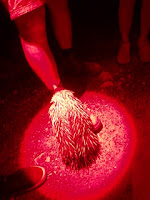I’m often asked, ‘Why is May Day Mine published in America?’ The reason is, I saw an advertisement in the Queensland Writers’ Centre (QWC) magazine. Harmony Ink Press, based in Tallahassee, Florida, was calling for young adult manuscripts, so I thought I’d give them a go. My first two children’s books, Cyclone Christmas and Block City (Sunshine Books, NZ), were also published after seeing an advertisement in the QWC magazine. It seems to me you have a greater chance of acceptance if you send your manuscripts to publishers who are actively seeking them.
After the first thrill of acceptance with Harmony Ink Press, there were legalities to complete. Everything was done electronically. After checking the contract thoroughly, I signed it with an electronic signature. Next, US copyright protection had to be applied for, and I also needed an Individual Taxpayer Identification Number (ITIN) from the Internal Revenue Service – this required a verified copy of my passport, a letter from the publishing company and an application form. All this was necessary to minimise the amount I would be taxed in the US, so I wouldn’t be taxed on my royalties twice. Harmony Ink Press advised and helped me with all of this.
All the editing was undertaken with three very respectful editors, communicating solely online. It was fascinating seeing their reactions to words and expressions I hadn’t realised were Australianisms. Interestingly, despite converting many words to American spelling, they wanted ‘Mum’ rather than ‘Mom’, as the story is set in Australia. Finally, two proof readers cast their eagle eyes over the galley proofs.
 |
| Read a review. |
Since publication, Harmony Ink Press have continued their support – they assisted me with a blog release party, are very supportive on social media, and always respond quickly and respectfully to any query I have.
Because I am published with an American publisher, even though they have a distributor in Australia, I have needed to be active in promoting myself here. Once published, I organised a launch, a press release, I was interviewed on ABC radio: How to write a book - and get published!, created promotional material including business cards and flyers, approached bookshops, and sought opportunities for public readings and reviews. In the US, representatives of Harmony Ink Press attend festivals and fairs, and it would be great if I could participate in those, but living in Australia, I have to leave the US marketing up to them.
My experience with being published in the USA has been a very positive one. With technology and a competent team, the great distance between us has been easily overcome. However, it would be so much fun to visit their premises in Tallahassee, and speak face to face with the team I have come to know so well online.

A little about Verity:
Verity Croker writes across a range of genres. May Day Mine, a young adult novel published by Harmony Ink Press, USA, was short-listed in the Dante Rossetti Awards. Her stories for 8-12 year olds, Cyclone Christmas and Block City, have been published by Sunshine Books, NZ. She has written travel articles for the RACT magazine Journeys, and also had articles published in The Canberra Times, NT News and Sunday Mail. Some of her short stories appear in journals, anthologies, and on ABC online. She is also a published poet.
Verity completed her Master of Arts (Specialisation: Creative Writing) at the University of Tasmania (UTAS) in 2013. She works at UTAS in Hobart, teaching English to international students.
W: www.veritycroker.wordpress.com
T: @veritycroker












